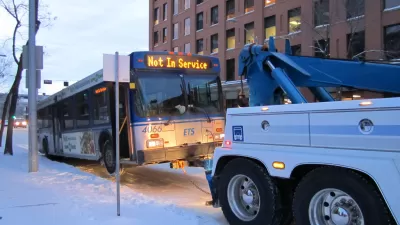Payton Chung summarizes a new report from the Transportation Research Board that reveals the indicators of successful transit projects.

Payton Chung reports on "Making Effective Fixed-Guideway Transit Investments: Indicators of Success," a Transit Cooperative Research Program (TCRP) report for the Transportation Research Board by researchers at the University of California, Berkeley. According to Chung, this "landmark report…identifies the factors that set successful transit investments apart from the rest." In his summary of the report, Chung notes that the study, which examined more than 140 elements of including location, demographic factors, and design of more than 55 rail and bus rapid transit systems, concluded that the secret to attracting high ridership is to "[serve] areas that are dense in both jobs and population and have expensive parking."
Per Chung, while the connection between high density jobs and population and transit is not new knowledge, the TCRP report's findings suggest "...access to these specific kinds of [high-wage] jobs, rather than to jobs in general, is a hallmark of transit-oriented metro areas...that perhaps easy transit access to high-wage jobs draws 'choice' riders out of cars and onto transit. Meanwhile, leisure jobs clustered around transit stations could be a proxy for '24-hour' mixed-use urban neighborhoods that draw transit riders throughout the day." Additionally, Chung notes that "the only design factor that seemed to have a significant effect on ridership was whether the route is grade-separated (in a tunnel or on a viaduct). In isolation, transit speed, frequency, or reliability did not have significant impacts, but the great advantage of grade-separated routes is that they can run quickly and reliably through high-density areas."
Chung adds, "The Berkeley researchers’ goal was to create an easy-to-use ridership forecasting model, built with data collected from finished projects across the country, that can help planners evaluate both individual transit routes and systemwide changes." The research team has provided a handy Excel file that can be used to predict riderships and cost estimates.
FULL STORY: The Secrets of Successful Transit Projects — Revealed!

Alabama: Trump Terminates Settlements for Black Communities Harmed By Raw Sewage
Trump deemed the landmark civil rights agreement “illegal DEI and environmental justice policy.”

Planetizen Federal Action Tracker
A weekly monitor of how Trump’s orders and actions are impacting planners and planning in America.

The 120 Year Old Tiny Home Villages That Sheltered San Francisco’s Earthquake Refugees
More than a century ago, San Francisco mobilized to house thousands of residents displaced by the 1906 earthquake. Could their strategy offer a model for the present?

In Both Crashes and Crime, Public Transportation is Far Safer than Driving
Contrary to popular assumptions, public transportation has far lower crash and crime rates than automobile travel. For safer communities, improve and encourage transit travel.

Report: Zoning Reforms Should Complement Nashville’s Ambitious Transit Plan
Without reform, restrictive zoning codes will limit the impact of the city’s planned transit expansion and could exclude some of the residents who depend on transit the most.

Judge Orders Release of Frozen IRA, IIJA Funding
The decision is a victory for environmental groups who charged that freezing funds for critical infrastructure and disaster response programs caused “real and irreparable harm” to communities.
Urban Design for Planners 1: Software Tools
This six-course series explores essential urban design concepts using open source software and equips planners with the tools they need to participate fully in the urban design process.
Planning for Universal Design
Learn the tools for implementing Universal Design in planning regulations.
Clanton & Associates, Inc.
Jessamine County Fiscal Court
Institute for Housing and Urban Development Studies (IHS)
City of Grandview
Harvard GSD Executive Education
Toledo-Lucas County Plan Commissions
Salt Lake City
NYU Wagner Graduate School of Public Service





























